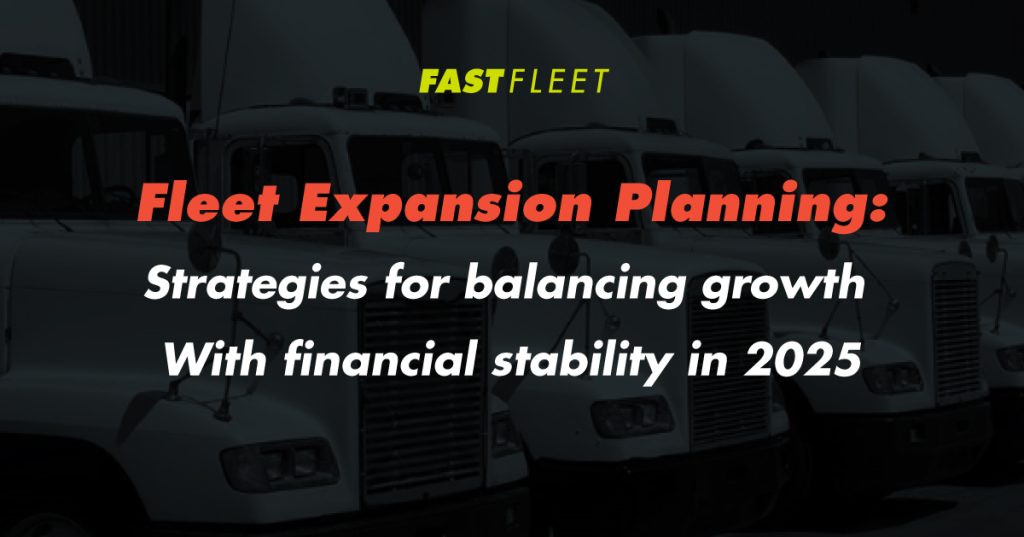Fleet expansion is a critical component for businesses aiming to scale their operations and enhance efficiency. However, the challenge lies in balancing this growth with financial stability. This comprehensive guide will walk you through the strategies needed to ensure a successful fleet expansion while maintaining a healthy financial footing.
Understanding the Need for Fleet Expansion
With the rapid evolution of market demands and technological advancements, expanding your fleet can significantly boost your business capabilities. Here are some of the key drivers and benefits of fleet expansion:
Current Market Trends Driving Fleet Expansion
- Increased Demand: The surge in e-commerce and logistics services has heightened the need for larger and more diverse fleets.
- Technological Advancements: New vehicle technologies, such as electric and autonomous vehicles, are transforming fleet operations, necessitating expansion and upgrades.
- Environmental Regulations: Stricter emissions standards are pushing businesses to invest in more eco-friendly vehicles.
Benefits of Expanding Your Fleet
- Increased Capacity: More vehicles mean you can handle more orders and larger projects.
- Improved Efficiency: Newer vehicles often come with better fuel efficiency and lower maintenance costs.
- Enhanced Competitiveness: A larger fleet can provide faster and more reliable service, giving you an edge over competitors.
Assessing Your Financial Health
Before embarking on an expansion plan, it’s crucial to have a clear understanding of your financial health.
Evaluating Your Current Financial Position
- Financial Statements Analysis: Review your balance sheet, income statement, and cash flow statement to get a comprehensive view of your financial standing.
- Debt Levels: Assess your current debt obligations and determine how much additional debt your business can handle.
- Liquidity Ratios: Check your liquidity ratios, such as the current ratio and quick ratio, to ensure you have enough short-term assets to cover immediate liabilities.
Key Financial Metrics to Monitor
- Gross Profit Margin: Indicates how well your company generates revenue compared to its costs.
- Operating Cash Flow: Measures the cash generated from your core business operations.
- Return on Investment (ROI): Calculates the potential return on the investments you’ll make in new fleet vehicles.
Developing a Strategic Fleet Expansion Plan
A well-structured plan is essential for a successful fleet expansion.
Setting Clear, Achievable Goals for Expansion
- Specific: Define the exact number of vehicles you plan to add and the timeline for acquisition.
- Measurable: Establish metrics to track the progress and success of your expansion.
- Achievable: Ensure your goals are realistic given your current financial and operational capabilities.
- Relevant: Align your expansion goals with your overall business objectives.
- Time-Bound: Set deadlines for each phase of the expansion plan.
Identifying the Right Time to Expand
- Market Conditions: Expand when the market demand is high and financing conditions are favorable.
- Internal Readiness: Ensure your internal processes, such as maintenance and driver management, can handle the increased workload.
Creating a Step-by-Step Expansion Plan
- Market Research: Conduct thorough market research to understand demand and competition.
- Budgeting: Develop a detailed budget covering all expenses related to the expansion.
- Vendor Selection: Choose reliable vendors for purchasing or leasing new vehicles.
- Staff Training: Train your staff to manage and operate the expanded fleet efficiently.
- Implementation: Execute the plan in phases, monitoring progress and making adjustments as needed.
Exploring Financing Options
Securing the right financing is crucial for a successful fleet expansion.
Traditional Financing Methods
- Bank Loans: A common option offering fixed or variable interest rates.
- Leasing: Allows you to use vehicles without the upfront costs of purchasing.
- Commercial Vehicle Loans: Specifically designed for financing commercial vehicles.
Alternative Financing Options
- Crowdfunding: Raise funds through platforms like Kickstarter or GoFundMe.
- Private Equity: Attract investment from private equity firms in exchange for a stake in your business.
- Venture Capital: Secure funding from venture capitalists who believe in your business model.
Federal Incentives and Grants
- Clean Vehicle Incentives: Federal and state incentives for purchasing eco-friendly vehicles.
- Small Business Grants: Various grants available for small businesses expanding their operations.
Budgeting for Expansion
Creating a realistic budget is vital to ensure financial stability during your expansion.
Estimating the Costs Involved in Fleet Expansion
- Vehicle Purchase or Lease: Calculate the total cost of acquiring new vehicles.
- Maintenance and Repairs: Factor in the ongoing maintenance and repair costs.
- Insurance: Ensure your new vehicles are adequately insured.
- Fuel Costs: Estimate the additional fuel costs for the expanded fleet.
Developing a Realistic Budget
- Fixed Costs: Include costs that remain constant, such as vehicle leases and insurance.
- Variable Costs: Account for costs that fluctuate, such as fuel and maintenance.
- Contingency Fund: Set aside a contingency fund to cover unexpected expenses.
Cost-Saving Strategies to Consider
- Bulk Purchasing: Negotiate discounts for purchasing multiple vehicles at once.
- Fuel-Efficient Vehicles: Invest in vehicles with better fuel efficiency to reduce long-term costs.
- Preventive Maintenance: Implement a preventive maintenance program to avoid costly repairs.
Mitigating Financial Risks
Identifying and mitigating financial risks is essential to protect your investment.
Identifying Potential Financial Risks
- Economic Downturns: A sudden downturn can impact your revenue and ability to service debt.
- Operational Risks: Increased operational complexity can lead to inefficiencies and higher costs.
- Regulatory Changes: New regulations can impose additional costs on your business.
Strategies to Mitigate These Risks
- Diversify Revenue Streams: Diversify your client base and service offerings to reduce dependency on a single source of income.
- Flexible Financing Options: Choose financing options that offer flexibility in repayment terms.
- Regular Financial Reviews: Conduct regular financial reviews to identify and address potential issues early.
Importance of Contingency Planning
- Emergency Fund: Maintain an emergency fund to cover unexpected expenses.
- Alternative Strategies: Develop alternative strategies to pivot quickly in response to market changes.
Leveraging Technology for Efficient Fleet Management
Technology plays a crucial role in managing an expanded fleet efficiently.
Role of Telematics and Fleet Management Software
- Real-Time Tracking: Use GPS tracking to monitor vehicle locations and optimize routes.
- Maintenance Alerts: Implement systems that provide alerts for scheduled maintenance and potential issues.
- Driver Behavior Monitoring: Monitor driver behavior to ensure safety and compliance.
Benefits of Using Technology for Cost Control and Efficiency
- Fuel Savings: Optimize routes and driving behavior to reduce fuel consumption.
- Improved Maintenance: Preventive maintenance programs reduce downtime and repair costs.
- Data-Driven Decisions: Use data analytics to make informed decisions and improve overall fleet performance.
Balancing growth with financial stability is key to a successful fleet expansion.
By understanding market trends, assessing your financial health, developing a strategic plan, exploring various financing options, budgeting carefully, mitigating risks, and leveraging technology, you can ensure a smooth and financially sound expansion.
Ensure your fleet is always on the move with reliable roadside repair services from Fast Fleet.
Contact us today to learn how we can support your fleet operations and keep your business running smoothly.
















